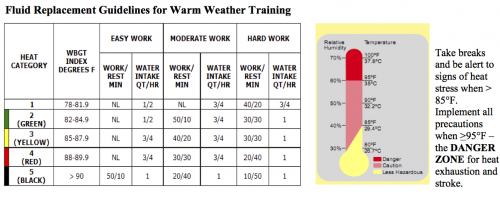Working in the heat can be risky to your health. Life-threatening problems can occur if your body is unable to stay cool enough in hot temperatures or
high humidity. Heat stress causes a range of health effects, which can lower your job performance and become life-threatening if left untreated.
Health Risks
- Heat stroke is life-threatening. Your body can no longer cool itself. You may have hot, dry skin, experience confusion, convulsions, or loss of consciousness. Heat stroke can kill. If you or a coworker experience symptoms, call 911 and get emergency medical help!
- Heat exhaustion develops when your body has lost too much fluid. Signs of heat exhaustion include damp, flushed skin, feeling tired, nauseous, headachy, or giddy.
- Heat cramps occur when salt your body loses from sweating isn’t replaced. They affect the muscles you use most and can set in after you’ve left work.
- Heat rash occurs when sweat can’t evaporate from your skin. It can make work activities difficult to perform.
PROTECT YOURSELF!
- Know and report early signs and symptoms.
- Drink water frequently.
- Take breaks in cool, shaded areas.
- Wear light-colored, loose-fitting clothing.
- Report problems with heat, AC or drinking water
Spotlight on Breaks: No OSHA standard exists on heat breaks. However, the chart below provides U.S. Army guidance for work/rest cycles and hydration practices based on the combined temperature and humidity (shown as the WBGT Index below left) and physical exertion. Remember, these are minimum guidelines, not strict rules. Take action as soon as you or a coworker begins to feel symptoms of heat stress!

A SAFE WORKPLACE IS YOUR RIGHT!
To protect workers from heat stress, employers can:
- Provide clean water in convenient locations at all work areas.
- Schedule frequent rest and water breaks.
- Reduce work demands or scheduling heavy labor for cooler times.
- Ensure adequate air circulation in work areas (e.g. ventilation).
- Provide adequate and immediate medical response in the event of heat stress.
- Choose PPE with heat stress in mind.
Factors Affecting Heat Stress Risk:
- High heat or humidity
- Clothing and PPE
- Physical exertion
- Air circulation (e.g. fan, breeze)
- Direct sun or extreme heat exposure
(e.g. hot equipment)
- Physical condition – You are at
greater risk if you:
are65+
are overweight
have heart disease
have high blood pressure
are sick or have been recently ill
• Acclimatization (heat tolerance) – Be extra careful during early summer and hot spells when your body is not as adapted.
DON’T “TOUGH IT OUT”….. A SUPERVISOR (OR COWORKER) MUST TAKE YOU TO A COOLER AREA IMMEDIATELY IF YOU FEEL FAINT, DIZZY OR CONFUSED…..IT IS A MEDICAL EMERGENCY!
